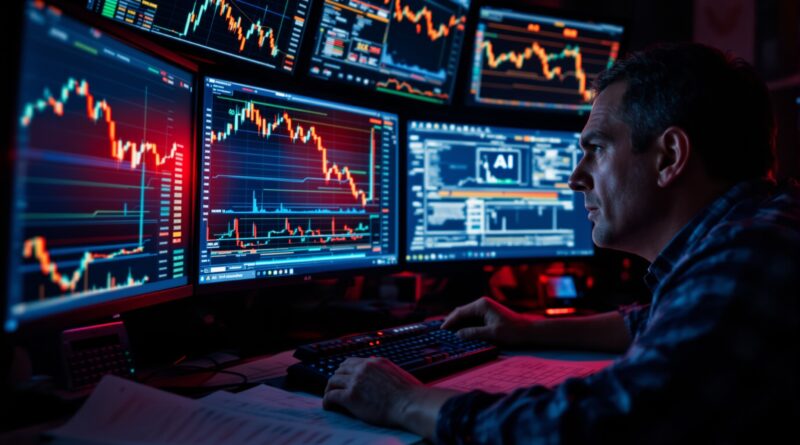Michael Burry AI Bets Warn of $1 Billion Nvidia Palantir Bubble
Michael Burry AI bets have once again captured Wall Street’s attention, echoing his legendary foresight from the 2008 housing crisis. The investor, immortalized in ‘The Big Short,’ recently disclosed massive put options against two AI giants: Nvidia and Palantir. These positions, totaling over $1.1 billion, suggest Burry sees an overhyped AI bubble ready to burst.
Scion Asset Management, Burry’s hedge fund, filed with the SEC revealing $187.6 million in puts on Nvidia and a staggering $912 million on Palantir for the third quarter. Puts are financial instruments that profit when stock prices fall, indicating Burry’s bearish stance on these stocks. This move comes as AI enthusiasm drives tech valuations to unprecedented heights.
Burry’s return to social media after a long hiatus amplified the buzz. He posted a cryptic message quoting his film portrayal: ‘Sometimes, we see bubbles. Sometimes, there is something to do about it.’ Investors interpret this as a direct warning about the AI surge, reminiscent of his subprime mortgage predictions.
Background on Michael Burry’s Investment Philosophy
Michael Burry built his reputation by spotting market inefficiencies others ignored. In 2005, he bet against the housing market using credit default swaps, profiting billions when it collapsed. His contrarian approach relies on deep analysis of fundamentals versus market hype.
Burry’s Michael Burry AI bets align with this philosophy. Nvidia, a leader in AI chips, has seen its stock soar over 150% in the past year, fueled by demand for graphics processing units in machine learning. However, Burry likely questions if growth can sustain such premiums amid rising competition and slowing innovation.
Palantir, known for data analytics software, has also ridden the AI wave, with shares up 152% this year. Burry’s large bet against it coincides with the company’s recent earnings beat, yet its valuation remains ‘extreme,’ as noted by analysts. This highlights Burry’s focus on overvaluation risks.
The Current AI Market Landscape
The AI sector has dominated markets, with the ‘Magnificent Seven’ tech stocks propelling the S&P 500 to record highs. Nvidia alone accounts for a significant portion of the index’s gains, its market cap exceeding $3 trillion. But concerns mount about circular financing, where AI firms fund each other’s growth in a self-reinforcing loop.
Recent market jitters underscore these worries. The Nasdaq dropped 2.04% in a single day, its worst since August, while the S&P 500 fell 1.17%. Palantir’s shares plunged 7.95% despite strong earnings, partly blamed on Burry’s comments fueling bubble fears.
Experts like Angelo Zino from CFRA Research agree a tech pullback is overdue after months of rallies. ‘Burry’s words exacerbated existing concerns,’ Zino said, pointing to high valuations and investor expectations. Yet, he advises not overreacting, as the pullback might be healthy.
Impact on Nvidia and Palantir Stocks
Nvidia’s stock dipped 3.96% following the disclosures, though it’s still up 48% year-to-date. The chipmaker faces scrutiny over its dominance, with rivals like AMD and Intel ramping up AI efforts. Burry’s Michael Burry AI bets could signal to investors that Nvidia’s growth story is priced too optimistically.
Palantir’s CEO Alex Karp fired back, calling short sellers like Burry ‘crazy.’ Karp emphasized the company’s pivotal role in AI software, vowing to outperform critics. Despite the tumble, Palantir remains a top S&P 500 performer, but Burry’s $912 million wager underscores valuation debates.
This follows recent Palantir earnings volatility, where strong results still led to a 6% drop amid broader tech slumps. Such events highlight the fragility of AI-driven stocks to sentiment shifts.
Historical Context: Burry’s Track Record
Burry isn’t infallible; he admitted error in a 2023 ‘Sell’ tweet that preceded a bull run. However, his long-term insights often prove prescient. The 2008 crisis netted Scion $2.69 billion, cementing his legend.
Similar to recent tech stock rebounds, AI has seen sharp corrections before surging higher. Burry’s bets recall the dot-com bubble, where hype outpaced profits, leading to a 78% Nasdaq crash.
Comparison to Past Bubbles
The dot-com era featured overvalued tech firms with little revenue; today’s AI shares boast strong earnings but face sustainability questions. Burry’s Michael Burry AI bets mirror George Soros’s 1992 pound short, profiting from perceived overvaluations.
Analysts compare this to the 2021 meme stock frenzy, where retail hype drove irrational prices. AI’s institutional backing makes it more entrenched, but Burry warns of complacency.
Stakeholders react variably. Investors in Nvidia and Palantir worry about downside risks, while AI proponents dismiss Burry as outdated. Customers reliant on these technologies fear supply disruptions if stocks tank.
Expert Opinions and Market Analysis
Wall Street veterans echo some concerns. Goldman Sachs CEO David Solomon downplays AI job loss fears but acknowledges investment returns lag for many firms. A recent report shows most companies aren’t yet profiting from AI spends.
CFRA’s Zino notes Palantir’s ‘stellar’ results but extreme multiples, around 100 times earnings. For Nvidia, forward P/E ratios exceed 40, far above historical norms. Burry’s positions amplify these metrics as red flags.
As reported in our coverage of the US-China AI race, geopolitical tensions add pressure. Nvidia CEO Jensen Huang warns of China’s rising dominance, potentially eroding US leads and justifying Burry’s caution.
Broader Economic Implications
If Burry’s thesis holds, an AI correction could drag the entire market. The S&P 500’s tech concentration—over 30%—means a sector slump impacts everyone. Economists predict slower growth if AI hype deflates without productivity gains.
Conversely, if AI delivers on promises, Burry’s bets could falter like his 2023 call. Optimists point to real-world applications in healthcare and autonomous driving boosting GDP by trillions.
Burry’s Michael Burry AI bets matter because they challenge the narrative. Investors should diversify, avoiding overexposure to any sector, as lessons from 2008 show.
Stakeholder Perspectives
Palantir’s Karp remains defiant, using criticism as motivation to deliver better numbers. Nvidia executives focus on innovation, unveiling new chips quarterly. Retail investors, enamored with AI, may ignore warnings, chasing momentum.
Regulators watch closely; the SEC scrutinizes short-selling amid volatility. Policymakers debate AI ethics and antitrust, with bills targeting big tech’s power.
From a global view, Europe’s tech lag makes it vulnerable to US corrections. Asia’s semiconductor hubs could benefit if supply chains shift.
Future Implications and What to Watch
Burry’s moves could trigger more short interest, pressuring prices. Upcoming earnings seasons will test AI firms’ narratives. Watch Fed rate decisions; higher rates hurt growth stocks like these.
What happens next? A mild correction might validate Burry without catastrophe. A full bubble burst could mirror 2000, wiping trillions. Investors should monitor insider sales and R&D spends for sustainability.
Practical takeaways: Review portfolios for AI overweights. Use tools like puts for hedging if risk-tolerant. Long-term, focus on diversified assets over hype.
Lessons for Everyday Investors
Burry teaches contrarian thinking: Question consensus. Explain valuations simply—P/E ratios show if prices match profits. For a $100 stock with $2 earnings, P/E is 50; ideal is 15-20 for stability.
Build emergency funds covering 3-6 months expenses. Avoid FOMO; dollar-cost average into indices for steady growth.
For readers interested in stock market basics, understanding fundamentals helps navigate volatility like Burry’s warnings.
Conclusion: Navigating the AI Landscape
Michael Burry AI bets spotlight risks in the AI boom, urging caution amid excitement. While not predicting doom, they remind us markets reward skepticism. Stay informed, diversify, and invest wisely.
Understanding index fund investing for beginners provides a balanced approach beyond single-stock bets. To grasp timeless strategies, explore Warren Buffett’s secrets to staying calm in volatile markets.
Source: CNN




